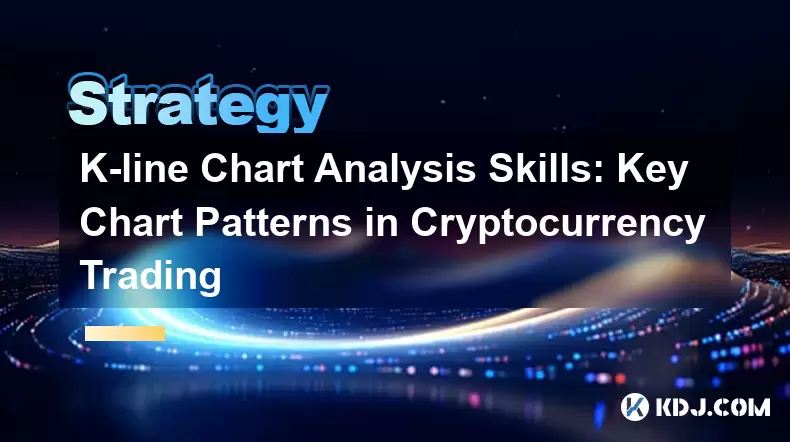-
 bitcoin
bitcoin $114320.977035 USD
-0.40% -
 ethereum
ethereum $4152.439985 USD
-1.75% -
 tether
tether $1.000111 USD
-0.04% -
 xrp
xrp $2.843037 USD
-1.63% -
 bnb
bnb $1013.349380 USD
-1.62% -
 solana
solana $208.362767 USD
-2.10% -
 usd-coin
usd-coin $0.999783 USD
0.00% -
 dogecoin
dogecoin $0.232559 USD
-1.00% -
 tron
tron $0.333491 USD
-1.09% -
 cardano
cardano $0.806310 USD
0.19% -
 hyperliquid
hyperliquid $45.023720 USD
-1.59% -
 ethena-usde
ethena-usde $1.000819 USD
-0.06% -
 chainlink
chainlink $21.241249 USD
-2.11% -
 avalanche
avalanche $30.035416 USD
-0.66% -
 stellar
stellar $0.364984 USD
-2.05%
K-line Chart Analysis Skills: Key Chart Patterns in Cryptocurrency Trading
Mastering K-line charts and reversal patterns like hammers, morning stars, and shooting stars can enhance crypto trading decisions when combined with volume and proper time frames.
Jun 13, 2025 at 10:21 am

Understanding the Basics of K-line Charts in Cryptocurrency Trading
K-line charts, also known as candlestick charts, are essential tools for analyzing price movements in cryptocurrency markets. Each candlestick represents a specific time frame and provides information about the open, high, low, and close (OHLC) prices during that period. In crypto trading, where volatility is common, mastering K-line chart reading can significantly improve decision-making.
The body of a candlestick shows the range between the opening and closing prices. If the close price is higher than the open, the candle is usually green or hollow; if lower, it's red or filled. The wicks or shadows above and below the body indicate the highest and lowest prices reached during the period.
Key Tip: Longer bodies suggest strong buying or selling pressure, while long wicks may signal rejection of certain price levels.
Identifying Bullish Reversal Patterns
In volatile crypto markets, recognizing bullish reversal patterns helps traders anticipate potential upward trends after a downtrend. One such pattern is the hammer, which features a small body at the top with a long lower wick. It suggests that sellers pushed the price down but were met with strong buying pressure by the end of the period.
Another reliable pattern is the morning star, consisting of three candles: a large bearish candle, followed by a small-bodied candle (either bullish or bearish), then a large bullish candle. This formation indicates a shift from seller dominance to buyer control.
- A hammer typically forms at the bottom of a downtrend
- The morning star confirms a reversal when the third candle closes beyond the midpoint of the first candle
Important Note: These patterns gain strength when they occur near key support levels or coincide with increased volume.
Recognizing Bearish Reversal Patterns
Just as important as spotting bullish reversals, identifying bearish reversal patterns helps traders exit positions before significant downturns. The shooting star is a single-candle pattern that appears at the top of an uptrend. It has a small body at the bottom with a long upper wick, indicating that buyers attempted to push prices higher but faced strong resistance.
The evening star mirrors the morning star but signals a reversal from bullish to bearish. It starts with a large bullish candle, followed by a small-bodied candle, then a large bearish candle that closes below the midpoint of the first candle.
- Shooting stars often appear after extended rallies
- Evening stars are more reliable when confirmed by subsequent bearish candles
Caution: Confirmation from other technical indicators like RSI or MACD enhances reliability.
Spotting Continuation Patterns
Not all K-line patterns signal reversals; some indicate that the current trend is likely to continue. The rising window is a gap between two candles with no overlap in their price ranges, showing strong momentum in the direction of the trend. In uptrends, rising windows confirm continued buying interest.
Another continuation pattern is the three white soldiers, which consists of three consecutive bullish candles with progressively higher closes. Each candle opens within the previous candle’s body and closes near its high, signaling steady accumulation.
- Rising windows are often seen in fast-moving crypto markets
- Three white soldiers work best after brief pullbacks within an uptrend
Observation: Continuation patterns help traders stay in winning trades instead of exiting prematurely.
Using Volume and Time Frames Effectively
While K-line patterns offer valuable insights, they should not be used in isolation. Combining them with volume analysis adds confirmation to the validity of a pattern. For example, a bullish engulfing pattern on high volume is more trustworthy than one on low volume.
Time frames also play a crucial role. Short-term traders may focus on 15-minute or 1-hour charts for quick entries, whereas swing traders might rely on daily or weekly charts for broader context. Aligning your strategy with the correct time frame ensures consistency in trade execution.
- High volume during a breakout increases the likelihood of success
- Different time frames reveal different aspects of market sentiment
Critical Insight: Always cross-check K-line signals with volume and align with your trading strategy’s time horizon.
Frequently Asked Questions
Q: Can K-line patterns be applied to all cryptocurrencies?Yes, K-line patterns are applicable across all cryptocurrencies since they reflect universal market psychology regardless of the asset.
Q: How reliable are K-line patterns in predicting price movements?Their reliability increases when combined with other technical tools like moving averages, Fibonacci retracements, and volume analysis.
Q: Do K-line patterns work better on certain time frames?They tend to be more accurate on higher time frames like 4-hour or daily charts due to reduced noise and clearer price action.
Q: Should I use K-line patterns alone for trading decisions?It's generally advisable to use them alongside other indicators and risk management strategies to avoid false signals.
Disclaimer:info@kdj.com
The information provided is not trading advice. kdj.com does not assume any responsibility for any investments made based on the information provided in this article. Cryptocurrencies are highly volatile and it is highly recommended that you invest with caution after thorough research!
If you believe that the content used on this website infringes your copyright, please contact us immediately (info@kdj.com) and we will delete it promptly.
- BlockDAG, DOGE, HYPE Sponsorship: Crypto Trends Shaping 2025
- 2025-10-01 00:25:13
- Deutsche Börse and Circle: A StableCoin Adoption Powerhouse in Europe
- 2025-10-01 00:25:13
- BlockDAG's Presale Buzz: Is It the Crypto to Watch in October 2025?
- 2025-10-01 00:30:13
- Bitcoin, Crypto, and IQ: When Genius Meets Digital Gold?
- 2025-10-01 00:30:13
- Stablecoins, American Innovation, and Wallet Tokens: The Next Frontier
- 2025-10-01 00:35:12
- NBU, Coins, and Crypto in Ukraine: A New Yorker's Take
- 2025-10-01 00:45:14
Related knowledge

Practical parameter settings for a Bitcoin multi-timeframe moving average system
Sep 18,2025 at 10:54pm
Optimizing Timeframe Combinations for Bitcoin Trading1. Selecting appropriate timeframes is crucial when building a multi-timeframe moving average sys...

How can I filter out false breakouts in Dogecoin high-frequency trading?
Sep 22,2025 at 01:00am
Understanding False Breakouts in Dogecoin Trading1. A false breakout occurs when Dogecoin's price appears to move beyond a defined support or resistan...

Techniques for identifying tops and bottoms in the Bitcoin on-chain NVT model
Sep 20,2025 at 07:54pm
Understanding the NVT Model in Bitcoin Analysis1. The Network Value to Transactions (NVT) ratio is often described as the 'P/E ratio' of the cryptocur...

What does the surge in open interest in Bitcoincoin futures mean?
Sep 20,2025 at 11:18pm
Understanding the Surge in Dogecoin Futures Open Interest1. A surge in open interest within Dogecoin futures indicates a growing number of active cont...

How can I use the Ethereum USDT premium to gauge market sentiment?
Sep 18,2025 at 11:55pm
Understanding the Ethereum USDT Premium1. The Ethereum USDT premium refers to the price difference between USDT (Tether) traded on Ethereum-based plat...

What should I do if Ethereum staking yields decline?
Sep 20,2025 at 06:18am
Understanding the Causes Behind Declining Ethereum Staking Yields1. The Ethereum network transitioned to a proof-of-stake consensus mechanism with the...

Practical parameter settings for a Bitcoin multi-timeframe moving average system
Sep 18,2025 at 10:54pm
Optimizing Timeframe Combinations for Bitcoin Trading1. Selecting appropriate timeframes is crucial when building a multi-timeframe moving average sys...

How can I filter out false breakouts in Dogecoin high-frequency trading?
Sep 22,2025 at 01:00am
Understanding False Breakouts in Dogecoin Trading1. A false breakout occurs when Dogecoin's price appears to move beyond a defined support or resistan...

Techniques for identifying tops and bottoms in the Bitcoin on-chain NVT model
Sep 20,2025 at 07:54pm
Understanding the NVT Model in Bitcoin Analysis1. The Network Value to Transactions (NVT) ratio is often described as the 'P/E ratio' of the cryptocur...

What does the surge in open interest in Bitcoincoin futures mean?
Sep 20,2025 at 11:18pm
Understanding the Surge in Dogecoin Futures Open Interest1. A surge in open interest within Dogecoin futures indicates a growing number of active cont...

How can I use the Ethereum USDT premium to gauge market sentiment?
Sep 18,2025 at 11:55pm
Understanding the Ethereum USDT Premium1. The Ethereum USDT premium refers to the price difference between USDT (Tether) traded on Ethereum-based plat...

What should I do if Ethereum staking yields decline?
Sep 20,2025 at 06:18am
Understanding the Causes Behind Declining Ethereum Staking Yields1. The Ethereum network transitioned to a proof-of-stake consensus mechanism with the...
See all articles










































































